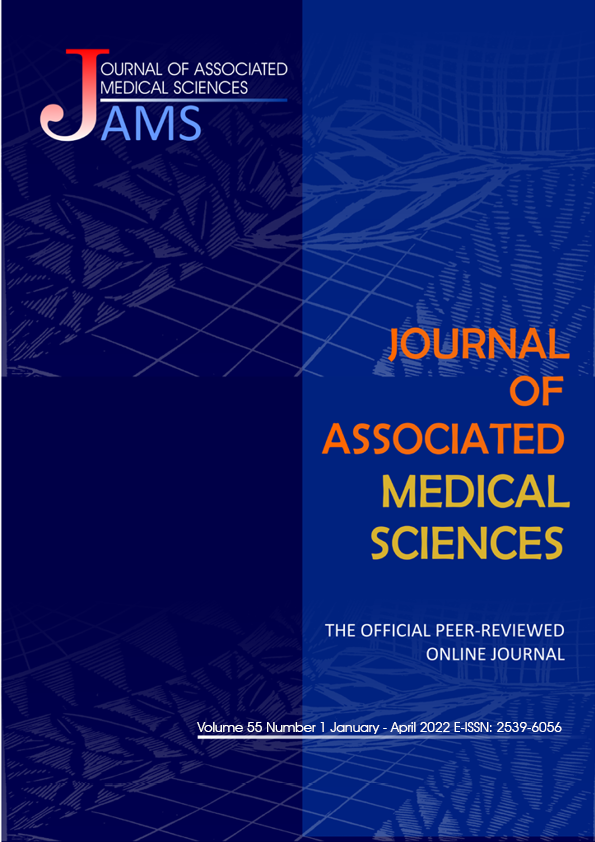Comparison of entrance surface air kerma to eye lens in head computed tomography protocols between 32-MDCT and 64-MDCT on an anthropomorphic phantom
Main Article Content
Abstract
Background: Brain multi-detector computed tomography (MDCT) is commonly performed for diagnosis of traumatic or non-traumatic brain injury cases. During brain CT scan, the eye lens is highly sensitive to radiation and may cause radiation-induced cataracts irradiated by CT primary beam.
Objectives: This study aimed to determine and compare entrance surface air kerma (ESAK) to the eye lens in clinical routine head protocols between 32-MDCT and 64-MDCT using an anthropomorphic phantom.
Materials and methods: A PBU-60 head phantom was scanned by 32-MDCT and 64-MDCT in helical, axial, and tilted axial modes used in clinical routine head protocols with tube voltage of 120 kVp, tube current of 108-150 mAs for 32-MDCT, and 200-310 mAs for 64-MDCT. The NanodotTM optically stimulated luminescent dosimeters (OSLDs) was used to measure ESAK to eye lens. Dose length product (DLP), normalized volume CT dose index (nCTDIvol), and normalized mean ESAK were compared between two CT scanners.
Results: The ranges of mean normalized ESAK to the eye lens in each scanning mode was found from 0.41±0.01 to 0.51±0.01 mGy/100 mAs for 32-MDCT and 0.30±0.01 to 0.40±0.01 mGy/100 mAs for 64-MDCT. The normalized ESAKs obtained from 64-MDCT were lower than 32-MDCT by 21.57-37.50%. The lowest normalized ESAK of 0.30±0.01 mGy/100 mAs was obtained in tilted axial scanning mode in 64-MDCT with the difference of 37.50% compared to 32-MDCT of using identical scanning mode.
Conclusion: This study demonstrated that normalized mean ESAK to the eye lens for 64-MDCT in all brain scanning protocols was lower compared to 32-MDCT. In addition, using tilting gantry in axial scanning mode as well as using an automatic tube current modulation system could be beneficial for reducing radiation dose to eye lens during brain CT in clinical routine.
Article Details

This work is licensed under a Creative Commons Attribution-NonCommercial-NoDerivatives 4.0 International License.
Personal views expressed by the contributors in their articles are not necessarily those of the Journal of Associated Medical Sciences, Faculty of Associated Medical Sciences, Chiang Mai University.
References
] Nishtar T, Ahmad T, Noor N, Muhammad F. Rational use of computed tomography scan head in the Emergency Department of a high-volume tertiary care public sector hospital. Pak J Med Sci.2019; 35(2): 302-08.
] Lolli V, Pezzullo M, Delpierre I, Sadeghi N. MDCT imaging of traumatic brain injury. Br J Radiol. 2016; 89(1061): 20150849.
] Anam C, Fujibuchi T, Toyoda T, Sato N, Haryanto F, Widita R, Arif I, Dougherty G. The impact of head miscentering on the eye lens dose in CT scanning: Phantoms study. Journal of Physics. J Radiol Prot. 2019; 39(1): 112-24.
] The 2007 Recommendations of the International Commission on Radiological Protection. ICRP publication 103. Ann ICRP. 2007; 37(2-4): 1-332.
] Khoramian D, Sistani S, Firouzjah AR. Assessment and comparison of radiation dose and image quality in multi-detector CT scanners in non-contrast head and neck examinations. Pol J Radiol. 2019; 84: 63-7.
] Kalra MK, Sodickson AD, Mayo-Smith WW. CT Radiation: Key Concepts for Gentle and Wise Use. Radiographics. 2015; 35(6): 1706-21.
] Nuntue C, Krisanachinda A, Khamwan K. Optimization of a low-dose 320-slice multi-detector computed tomography chest protocol using a phantom. Asian Biomedicine.2016; 10(3): 269-76.
] Poon R, Badawy MK. Radiation dose and risk to the lens of the eye during CT examinations of the brain. J Med Imaging Radiat Oncol. 2019; 63(6): 786-94.
] Nikupaavo U, Kaasalainen T, Reijonen V, Ahonen S M, Kortesniemi M. Lens dose in routine head CT: comparison of different optimization methods with anthropomorphic phantoms. Am. J. Roentgenol. 2015; 204(1): 117–23.
] Merzan D, Nowik P, Poludniowski G, Bujila R. Evaluating the impact of scan setting on automatic tube current modulation in CT using a novel phantom. Br J RAdiol. 2017; 90 doi:10.1259/bjr.2016308.
] Yahnke CJ. Calibrating the microStar. Landauer inLight Systems.; 2009.
] Sacraboro SB, Cody D, Alvarez P, Followill D. Characterization of the nanoDot OSLD dosimeter in CT. Medical physics. 2015; 42(4): 1797-807.
] Perks CA, Yahnke C, Million M. Medical dosimetry using Optically Stimulated Luminescence dots and microStar readers. Proceedings of 12th International Congress of the International Radiation Protection Association; 2008.
] Sookpeng S, Butdee C. Signal-to-noise ratio and dose to the lens of the eye for computed tomography examination of the brain using an automatic tube current modulation system. Emerg Radiol. 2017; 24(3): 233–39.
] Zhang D, Cagnon CH, Villablanca JP, McCollough CH, Cody DD, Stevens DM, Zankl M, Demarco JJ, Turner AC, Khatonabadi M, McNitt-Gray MF. Peak skin and eye lens radiation dose from brain perfusion CT based on Monte Carlo simulation. Am. J. Roentgenol. 2012; 198(2): 412–7.
] Lee CH, Goo JM, Lee HJ, Ye SJ, Park CM, Chun EJ et al. Radiation Dose Modulation Techniques in the Multidetector CT Era: From Basics to Practice.Radiographics. 2008; 28(5): 1451-60.
] Soderberg M, Gunnarsson M. Automatic exposure control in computed tomography--an evaluation of systems from different manufacturers. Acta Radiol. 2010; 51(6): 625-34.
] Christner JA, Kofler JM, McCollough CH.Estimating Effective Dose for CT Using Dose–Length Product Compared With Using Organ Doses: Consequences of Adopting. AJR. 2010; 194(4): 881-9.
] McKenney S, Bakalyar D, Boone J. SU‐C‐12A‐06: A Universal Definition for CT Irradiated Length. Medical Physics. 2014; 41(6Part3): 107 doi:10.1118/ 1.4887855.
] Sodkokkruad P, Asavaphatiboon S, Thanabodeebonsiri J, Tangboonduangjit P. Comparison of computed tomography dose index measuring by two detector types of computed tomography simulator. Thai J Rad Tech 2018; 43(1): 64-8.


